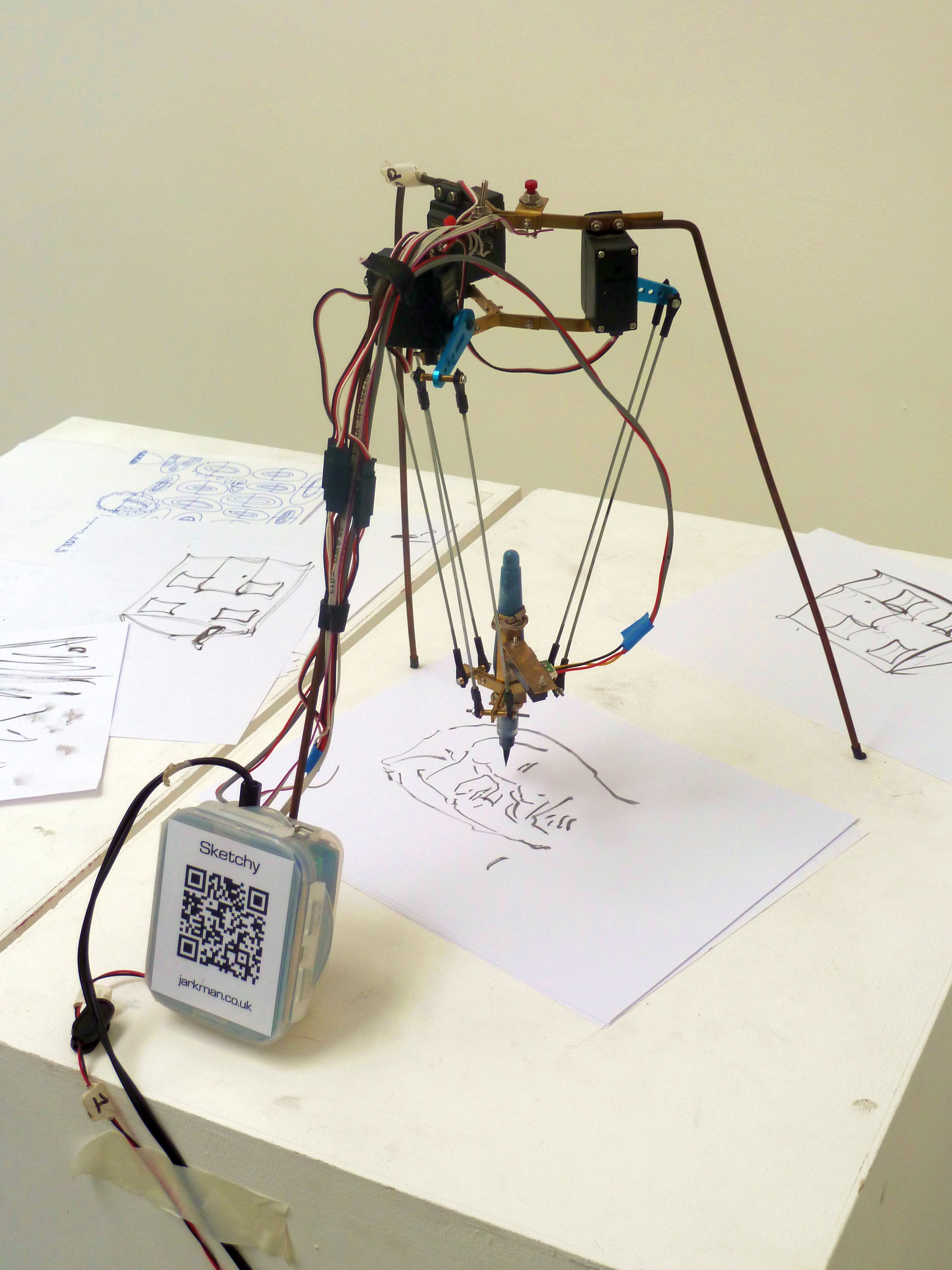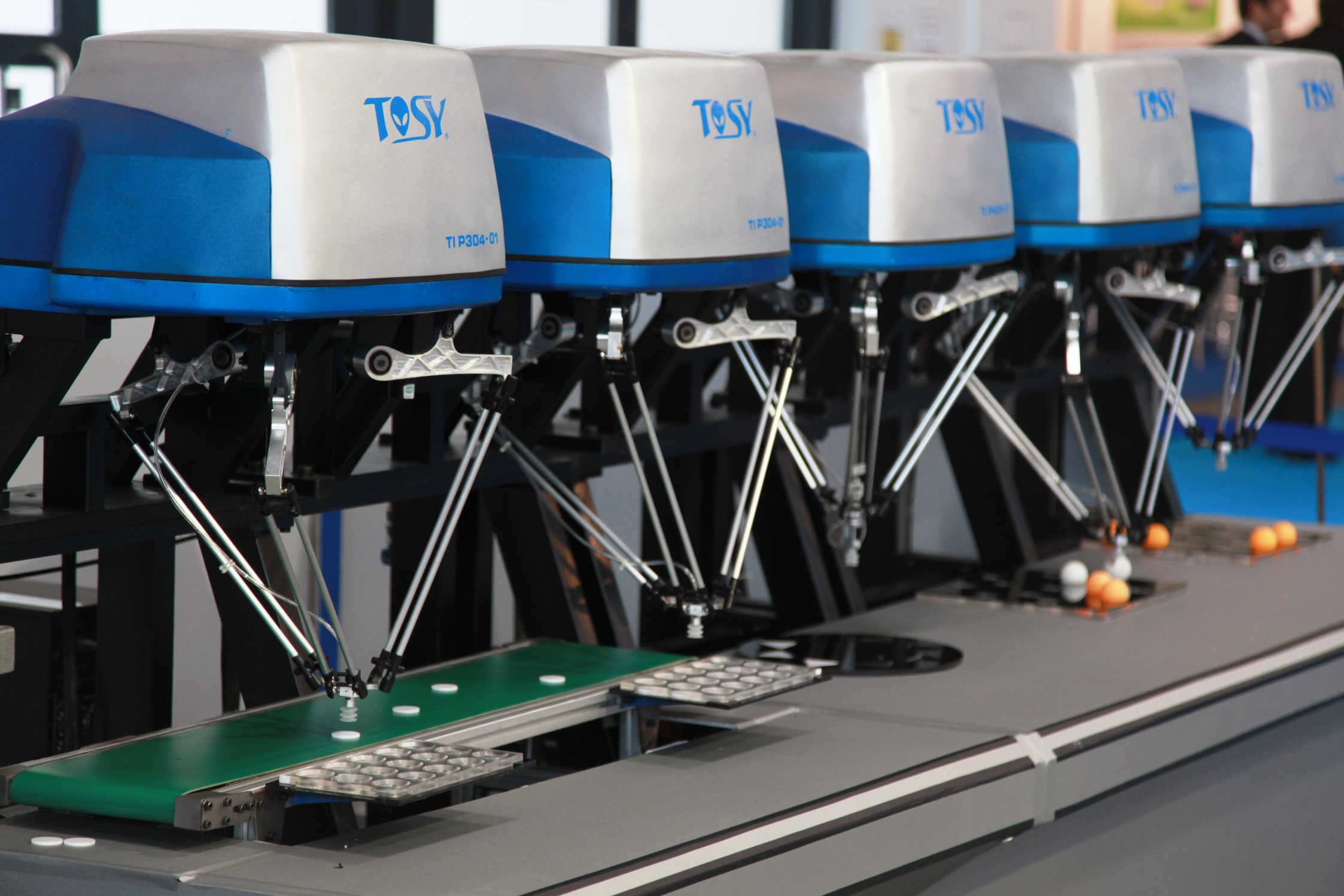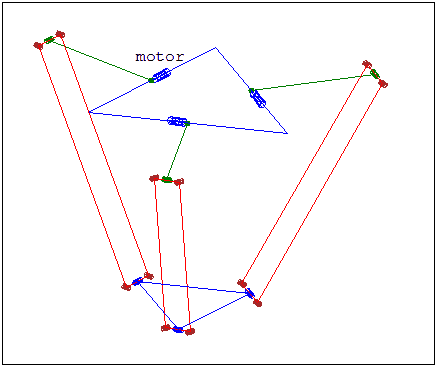Delta robot on:
[Wikipedia]
[Google]
[Amazon]
 A delta robot is a type of parallel robot that consists of three arms connected to
A delta robot is a type of parallel robot that consists of three arms connected to
 The delta robot (a parallel arm robot) was invented in the early 1980s by a research team led by professor Reymond Clavel at the
The delta robot (a parallel arm robot) was invented in the early 1980s by a research team led by professor Reymond Clavel at the
Conception d'un robot parallèle rapide à 4 degrés de liberté
PhD Thesis, EPFL, Lausanne, Switzerland and received the golden robot award in 1999 for his work and development of the delta robot. Also in 1999, ABB Flexible Automation started selling its delta robot, the FlexPicker. By the end of 1999, delta robots were also sold by Sigpack Systems. In 2017, researchers from Harvard's Microrobotics Lab

 The delta robot is a parallel robot, i.e. it consists of multiple kinematic chains connecting the base with the end-effector. The robot can also be seen as a spatial generalisation of a
The delta robot is a parallel robot, i.e. it consists of multiple kinematic chains connecting the base with the end-effector. The robot can also be seen as a spatial generalisation of a
Asyril SA
a 3-axis version of the delta robot adapted for flexible part feeding systems and other high-speed, high-precision applications. * Delta direct drive: a 3 degrees of freedom delta robot having the motor directly connected to the arms. Accelerations can be very high, from 30 up to 100 g. * Delta cube: developed by the EPFL university laboratory LSRO, a delta robot built in a monolithic design, having flexure-hinges joints. This robot is adapted for ultra-high-precision applications. * Several "linear delta" arrangements have been developed where the motors drive linear actuators rather than rotating an arm. Such linear delta arrangements can have much larger working volumes than rotational delta arrangements. The majority of delta robots use rotary actuators. Vertical linear actuators have recently been used (using a linear delta design) to produce a novel design of
 Industries that take advantage of the high speed of delta robots are the packaging industry, medical and pharmaceutical industry. For its stiffness it is also used for surgery. Other applications include high precision assembly operations in a
Industries that take advantage of the high speed of delta robots are the packaging industry, medical and pharmaceutical industry. For its stiffness it is also used for surgery. Other applications include high precision assembly operations in a
 A delta robot is a type of parallel robot that consists of three arms connected to
A delta robot is a type of parallel robot that consists of three arms connected to universal joints
A universal joint (also called a universal coupling or U-joint) is a joint or coupling connecting rigid shafts whose axes are inclined to each other. It is commonly used in shafts that transmit rotary motion. It consists of a pair of hinges loca ...
at the base. The key design feature is the use of parallelograms in the arms, which maintains the orientation of the end effector. In contrast, Stewart platform can change the orientation of its end effector.Bonev, I. The True Origins of Parallel Robots. Online article available at http://www.parallemic.org/Reviews/Review007.html
Delta robots have popular usage in picking and packaging in factories because they can be quite fast, some executing up to 300 picks per minute.
History
École Polytechnique Fédérale de Lausanne
École may refer to:
* an elementary school in the French educational stages normally followed by secondary education establishments (collège and lycée)
* École (river), a tributary of the Seine flowing in région Île-de-France
* École, Savoi ...
(EPFL, Switzerland). After a visit to a chocolate maker, a team member wanted to develop a robot to place pralines in their packages. The purpose of this new type of robot was to manipulate light and small objects at a very high speed, an industrial need at that time.
In 1987, the Swiss company Demaurex purchased a license for the delta robot and started the production of delta robots for the packaging industry. In 1991, Reymond Clavel presented his doctoral thesis 'Conception d'un robot parallèle rapide à 4 degrés de liberté',Clavel, R. (1991Conception d'un robot parallèle rapide à 4 degrés de liberté
PhD Thesis, EPFL, Lausanne, Switzerland and received the golden robot award in 1999 for his work and development of the delta robot. Also in 1999, ABB Flexible Automation started selling its delta robot, the FlexPicker. By the end of 1999, delta robots were also sold by Sigpack Systems. In 2017, researchers from Harvard's Microrobotics Lab
miniaturized
Miniaturization ( Br.Eng.: ''Miniaturisation'') is the trend to manufacture ever smaller mechanical, optical and electronic products and devices. Examples include miniaturization of mobile phones, computers and vehicle engine downsizing. In ele ...
it with piezoelectric actuators to 0.43 grams for 15 mm x 15 mm x 20 mm, capable of moving a 1.3 g payload around a 7 cubic millimeter workspace with a 5 micrometers precision, reaching 0.45 m/s speeds with 215 m/s² accelerations and repeating patterns at 75 Hz.
Design

 The delta robot is a parallel robot, i.e. it consists of multiple kinematic chains connecting the base with the end-effector. The robot can also be seen as a spatial generalisation of a
The delta robot is a parallel robot, i.e. it consists of multiple kinematic chains connecting the base with the end-effector. The robot can also be seen as a spatial generalisation of a four-bar linkage
In the study of mechanisms, a four-bar linkage, also called a four-bar, is the simplest closed-chain movable linkage. It consists of four bodies, called ''bars'' or ''links'', connected in a loop by four joints. Generally, the joints are config ...
.
The key concept of the delta robot is the use of parallelograms which restrict the movement of the end platform to pure translation, i.e. only movement in the X, Y or Z direction with no rotation.
The robot's base is mounted above the workspace and all the actuators are located on it. From the base, three middle jointed arms extend. The ends of these arms are connected to a small triangular platform. Actuation of the input links will move the triangular platform along the X, Y or Z direction. Actuation can be done with linear
Linearity is the property of a mathematical relationship ('' function'') that can be graphically represented as a straight line. Linearity is closely related to '' proportionality''. Examples in physics include rectilinear motion, the linear ...
or rotational actuators, with or without reductions (direct drive
A direct-drive mechanism is a mechanism design where the force or torque from a prime mover is transmitted directly to the effector device (such as the drive wheels of a vehicle) without involving any intermediate couplings such as a gear train o ...
).
Since the actuators are all located in the base, the arms can be made of a light composite material
A composite material (also called a composition material or shortened to composite, which is the common name) is a material which is produced from two or more constituent materials. These constituent materials have notably dissimilar chemical or ...
. As a result of this, the moving parts of the delta robot have a small inertia
Inertia is the idea that an object will continue its current motion until some force causes its speed or direction to change. The term is properly understood as shorthand for "the principle of inertia" as described by Newton in his first law ...
. This allows for very high speed and high acceleration
In mechanics, acceleration is the rate of change of the velocity of an object with respect to time. Accelerations are vector quantities (in that they have magnitude and direction). The orientation of an object's acceleration is given by t ...
s. Having all the arms connected together to the end-effector increases the robot stiffness, but reduces its working volume.
The version developed by Reymond Clavel has four degrees of freedom: three translations and one rotation. In this case a fourth leg extends from the base to the middle of the triangular platform giving to the end effector a fourth, rotational degree of freedom around the vertical axis.
Currently other versions of the delta robot have been developed:
* Delta with 6 degrees of freedom: developed by the Fanuc
FANUC ( or ; often styled Fanuc) is a Japanese group of companies that provide automation products and services such as robotics and computer numerical control wireless systems. These companies are principally of Japan, Fanuc America Corpor ...
company, in this robot a serial kinematic with 3 rotational degrees of freedom is placed on the end effector
* Delta with 4 degrees of freedom: developed by the Adept
An adept is an individual identified as having attained a specific level of knowledge, skill, or aptitude in doctrines relevant to a particular author or organization.
He or she stands out from others with their great abilities. All human quali ...
company, this robot has 4 parallelogram directly connected to the end-platform instead of having a fourth leg coming in the middle of the end-effector
* Pocket Delta: developed by the Swiss companAsyril SA
a 3-axis version of the delta robot adapted for flexible part feeding systems and other high-speed, high-precision applications. * Delta direct drive: a 3 degrees of freedom delta robot having the motor directly connected to the arms. Accelerations can be very high, from 30 up to 100 g. * Delta cube: developed by the EPFL university laboratory LSRO, a delta robot built in a monolithic design, having flexure-hinges joints. This robot is adapted for ultra-high-precision applications. * Several "linear delta" arrangements have been developed where the motors drive linear actuators rather than rotating an arm. Such linear delta arrangements can have much larger working volumes than rotational delta arrangements. The majority of delta robots use rotary actuators. Vertical linear actuators have recently been used (using a linear delta design) to produce a novel design of
3D printer
3D printing or additive manufacturing is the construction of a three-dimensional object from a CAD model or a digital 3D model. It can be done in a variety of processes in which material is deposited, joined or solidified under computer co ...
. These offer advantages over conventional leadscrew-based 3D printers of quicker access to a larger build volume for a comparable investment in hardware.
Applications
 Industries that take advantage of the high speed of delta robots are the packaging industry, medical and pharmaceutical industry. For its stiffness it is also used for surgery. Other applications include high precision assembly operations in a
Industries that take advantage of the high speed of delta robots are the packaging industry, medical and pharmaceutical industry. For its stiffness it is also used for surgery. Other applications include high precision assembly operations in a clean room
A cleanroom or clean room is an engineered space, which maintains a very low concentration of airborne particulates. It is well isolated, well-controlled from contamination, and actively cleansed. Such rooms are commonly needed for scientif ...
for electronic components. The structure of a delta robot can also be used to create haptic controllers. More recently, the technology has been adapted to 3D printers
3D printing or additive manufacturing is the construction of a three-dimensional object from a CAD model or a digital 3D model. It can be done in a variety of processes in which material is deposited, joined or solidified under computer co ...
. These printers are faster and can be built for about 200 dollars and compete well with traditional Cartesian and CoreXY printers.
References
{{DEFAULTSORT:Delta Robot Robot kinematics Industrial robots Parallel robots